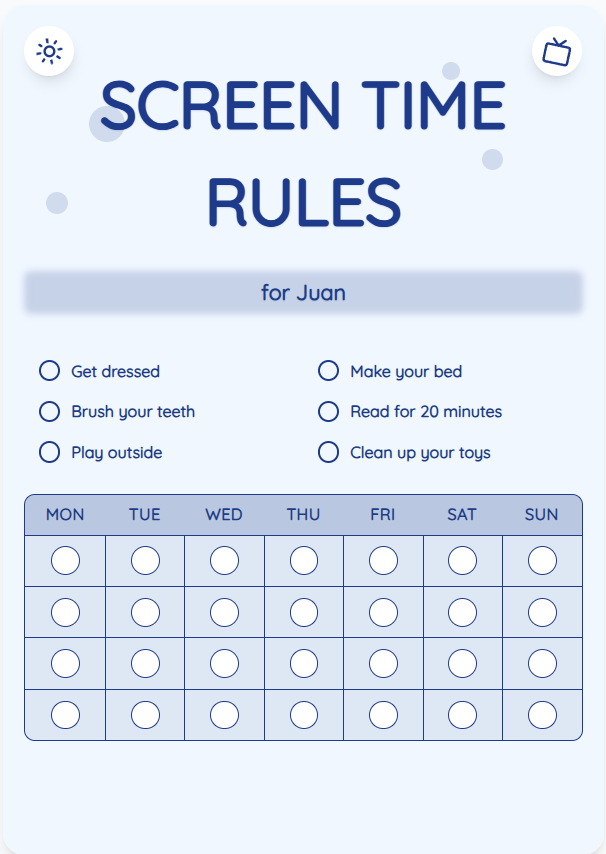How to Set an Effective Screen Time Limit for Your Child
As parents, managing our children's screen time can be a challenging task in today's digital age. Finding the right balance between technology use and other activities is crucial for their development and well-being. In this guide, we'll explore practical strategies to help you establish a suitable screen time limit for your child, promoting a harmonious family environment.
See What Your Screen Time Chart Will Look Like
Here's an example of a beautiful, customizable screen time rules chart you can create for your family

Understanding the Importance of Setting Screen Time Limits
Limiting screen time is essential as excessive use of electronic devices can have negative impacts on children's physical health, mental well-being, and social skills. By setting clear boundaries, you can encourage healthy habits and foster a balanced lifestyle for your child.
Practical Tips for Establishing an Effective Screen Time Routine
1. Create a screen time schedule that includes designated time slots for various activities. 2. Use screen time charts as visual aids to help your child understand and follow the limits. 3. Encourage alternative activities such as outdoor play, reading, and creative hobbies to reduce screen dependency. 4. Be consistent and lead by example by limiting your own screen time in front of your child.
Put These Tips Into Action
Create a custom chart to implement these strategies with your child
Setting Realistic Expectations and Adjusting Screen Time Limits
It's important to set realistic expectations based on your child's age, interests, and developmental stage. Monitor their screen time usage regularly and be prepared to adjust the limits as needed. Open communication and flexibility are key to finding a balance that works for your family.
Practical Tips for Success
- Use a screen time chart to visually represent and track your child's daily screen time allowance.
- Involve your child in creating their screen time schedule to promote ownership and responsibility.
- Set specific rules around when and where screens can be used to avoid conflicts.
- Encourage offline activities that promote physical activity and social interaction.
Frequently Asked Questions
How much screen time is recommended for children aged 2-12?
The American Academy of Pediatrics recommends limiting screen time to 1 hour per day for children aged 2-5 and establishing consistent limits for older children while ensuring they have ample time for sleep, physical activity, and social interactions.
How can I deal with resistance from my child when enforcing screen time limits?
It's common for children to resist screen time limits, but consistency and positive reinforcement are key. Clearly communicate the rules, offer incentives for following them, and provide engaging alternatives to screen time.
Are there any benefits to using screen time charts for managing screen time?
Screen time charts serve as visual tools that help children understand and adhere to screen time limits. They provide a clear structure, promote accountability, and make it easier for parents and children to track usage patterns and make adjustments as needed.
By implementing these practical tips and strategies, you can effectively manage your child's screen time and promote a healthy balance between digital activities and other enriching experiences. Visit ScreenTimeRules.com to access customizable screen time charts and resources to support your journey towards responsible screen time use.
Ready to Transform Your Family's Screen Time?
Join thousands of parents who have successfully managed screen time with our customizable charts.
